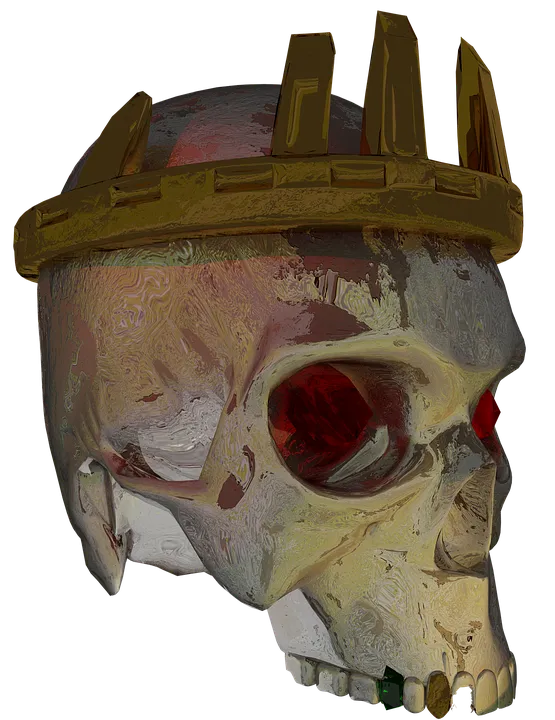The king is cursed and bears the worst
Dear reader, my tale continues thus. In previous ages mystic yogis would be able to enter a state of deep trance after many years of practice. And they could stay in that state for days on end, perhaps even longer. Who am I to be able to comprehend such inconceivable and profound concepts? Still I narrate them to you as I heard them from the ancient texts. At the top of the “eight-fold path” of yoga, called in Sanskrit “astanga yoga” (“asta=eight; anga=limbs) we have the goal called “samadhi”.

Such advanced sages existed back then, thousands of years ago, who could enter the sate of samadhi. Perhaps even in recent times they may still have existed, although hidden in the high mountain caves, far away from the degraded civilization around them.
After all, if a materialistic, greedy and unscrupulous person, like a military leader, were to come across such a man of mystic power, he might want to exploit that power for his own selfish ends and thus create great havoc upon the earth. Therefore it is far better that such yogis and mystics remain hidden from the eyes of the degraded civilization of today.
This narration of this pastime of King Pariksit, although occurring five thousand years ago already, signified the beginning of just such a fall from grace, where the king mistook the behavior of the mystic, became bewildered and acted inappropriately. The iron age of Kali had already set in and the times had shifted toward the dark winter of consciousness.
Feeling insulted, the wise and pious king Pariksit fell under the illusion of the iron age and caused the first rift between a king and his esteemed spiritual advisors, the great sages and mystics of the day. He decided to leave the yogi seated there, but as he did so, he saw a dead snake lying nearby.
In an agitated mindset, he picked up the dead snake with the corner of his bow and placed it around the shoulders of the mystic sage who sat in meditation. Thereafter he left the hermitage in the forest and headed back towards his palace. Now this, in and of itself, might have come to nothing. After all, the king realized that he may have acted inappropriately and the sage was not at all affected by the mere gesture of having the snake placed on his shoulders.
If that was all that happened, then nothing would have come of it. However, the son of the sage, also a brahmana priest like his father, heard of the event and became extremely angry. In those days the children were raised in the same vocation as their parents and acquired the training from early on to really master the family arts. Yet the boy was only twelve years old and still somewhat immature. Nevertheless, he already had a degree of power, based on his training and practice under the tutelage of his priestly father.
And this is where the iron age unfortunately took its toll. Not only did the kings become puffed up, so to speak by their prestige, but the priestly class also became distorted in their thinking. Thus the boy in his anger decided to use his newly acquired mystic powers to invoke a curse upon the king. By the correct use of mantras and mystic spells, the mystics, priests and yogis of the previous age were able to harness great forces beyond those that we are familiar with today.
By merely reciting the right spell or mantra, with the correct procedures, great forces could be invoked. His eyes red with anger, the brahmana boy, named Sringi, unleashed a curse upon the king as follows: “For his impudence at insulting my father, King Pariksit is hereby cursed to be bitten by a ‘snake bird’ within seven days from now and die.” He then went to his father and cried out upon seeing the snake hanging around the sage’s neck.
This brought the sage out of his trance state of meditation. Upon returning to waking consciousness he merely removed the dead snake and asked his son what had happened. Upon hearing of His son’s cursing of the king, he was not very happy. After all, the king was a pious ruler and protector of the citizens. Without a pious ruler the citizens would become harassed by unscrupulous people and society would become degraded.
And this is how the iron age really began. It was the immature reaction of the brahmana boy Sringi that triggered the demise of the pious rulers which led to the downfall of society as a whole. Naturally all this was already pre-ordained and took place as a result of the advent of the iron age itself in which we still find ourselves today.
One can debate whether it was the fall of the priestly class or the abuse of the ruling class, but either way, it was actually the end of that third age and the start of the fourth and final age of iron. Civilization was always destined to degrade under this shift, as is the natural course of events on the great cosmic time scale.
Tune in for the next episode tomorrow to find out how the narration of the ages unfolds still further.
(image pixabay)
